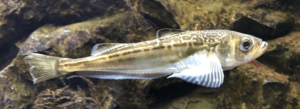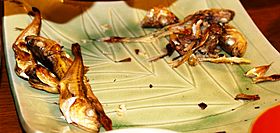Sailfin sandfish facts for kids
Quick facts for kids Sailfin sandfish |
|
|---|---|
 |
|
| Scientific classification | |
| Synonyms | |
|
The sailfin sandfish (Arctoscopus japonicus), also known as the Japanese sandfish, is a type of fish found in the ocean. It belongs to a group of fish called Percomorpha, which are like perch. In Japan, it's known as hatahata (ハタハタ, 鰰, 鱩, 燭魚). This fish is very important for fishing, especially in the Akita and Yamagata areas of Japan. You can find it living on sandy and muddy parts of the ocean floor, from the Sea of Japan to the Sea of Okhotsk.
People mostly catch this fish near the coast of the Sea of Japan. It's so important to Akita Prefecture that it's their official prefectural fish! The sailfin sandfish doesn't have scales. People often cook it whole, either by braising (cooking slowly in liquid) or grilling. It has a slightly slimy texture. It can also be dried to make stockfish, or salted and dried to make himono. Sometimes, it's cured in miso paste, which is called misozuke. This fish is also the main ingredient for a fish sauce called shottsuru. The fish eggs are known as burikko. In Korean, this fish is called 도루묵 (dorumuk). A long time ago, even into the 1900s, dried sailfin sandfish or fish meal was used as fertilizer for farms.
Contents
Life Cycle and Behavior
The sailfin sandfish can live for about 5 years. It usually grows to be about 20 centimeters (8 inches) long. This fish lives deep in the ocean, typically on sandy or muddy seabeds, about 200 to 400 meters (650 to 1,300 feet) deep. However, from November to January, it moves to shallower, rocky areas with seaweed to lay its eggs. Male fish are ready to reproduce when they are about 1 and a half years old, and females when they are 2 years old. These fish don't die after laying eggs once; they can reproduce several times during their lives.
The sailfin sandfish eats small sea creatures like amphipods, copepods, mysidacea, krill, squid, and other small fish.
Where They Live
You can find the sailfin sandfish in the northwestern Pacific Ocean. This includes the Sea of Japan, the Sea of Okhotsk, the Kurile Islands, and the Kamchatka Peninsula.
Scientists have found that there are three main groups of sailfin sandfish populations:
- Western Japan (WJ) – These fish travel along the coast of the Sea of Japan, from Tottori to Akita.
- South Hokkaido (SH) – This group lays its eggs in the Pacific Ocean near Hokkaido.
- Eastern Korea (EK) – This group lays its eggs along the eastern coast of the Korean Peninsula.
Even though some sailfin sandfish are caught on the Pacific coast of Japan (the Tōhoku region), there aren't many places where they regularly lay eggs there. These fish can travel very far.
How They Look
The sailfin sandfish is silvery underneath and light brown on top, with dark brown stripes and spots. Its body is quite tall, but not as tall as its relative, the Pacific sandfish. Its head and body don't have scales.
It has a large mouth that points upwards, filled with rows of tiny teeth. Each gill-flap on its cheek has five sharp spines. It has two separate fins on its back. Its pectoral fins (side fins) are very large. This fish does not have an air-bladder, which helps many fish float. During the day, it's active at night, and during the day, it often buries itself in the mud or sand on the seafloor, with only its mouth and eyes (and a spine) showing.
The fish eggs (roe) are usually green. However, they can also be yellow, red, or brown. The color of the eggs depends on different pigments inside them. Scientists believe that what the fish eats, like certain types of carotenoids, can change the color of its eggs.
Classification
Currently, the sailfin sandfish is grouped with fish in the Perciformes order (like perch) and the Trichodontidae family (sandfishes). However, studies of its mitochondrial DNA suggest it might be more closely related to fish in the Cottus group.
Similar Species
- The Pacific sandfish (Trichodon trichodon), also called ezo hatahata in Japanese, is found from the Aleutian Islands to Alaska and down to California.
What's in a Name?
The Japanese name hatahata can be written using a special character 鰰. This character combines the symbol for fish (魚) with the symbol for "god" (kami (神)). One old story says it's written this way because its skin looked like Mount Fuji, making it a lucky fish, even though it doesn't have scales!
Another Japanese name for it is kaminari-uwo (雷魚), which means "thunder fish." This name comes from the fact that people catch and the fish lay their eggs during the months when thunderstorms are common. In fact, hatahata itself is an old sound word for the clap of thunder.
In the local Akita dialect, hatahata sounds a bit like hadahada. In Akita, the fish is sometimes called "satake uo" after the Satake clan, who ruled the area around the 1600s. There's a legend that the fish followed the Satake family from their old home. In Tottori Prefecture, the fish is called shirohata or kitaha.
Fishing for Sailfin Sandfish
Fishermen catch sailfin sandfish using different methods. They use bottom trawling in deeper waters offshore. Closer to the coast, especially during spawning season, they use set-netting and gillnetting. In some areas, they use Danish seine fishing.
In Akita Prefecture, families used to buy large amounts of sailfin sandfish when they were in season. Any extra fish would be preserved by salting or pickling in rice bran (called nukazuke) to eat throughout the winter.
In the 1950s, Japan caught about 10,000 tons of sailfin sandfish each year. By the early 1970s, Korean fishermen were catching almost as much. The most fish ever caught in one year was in 1971, with 56,700 tons globally. However, by 1979, the number of fish dropped sharply to only 11,546 tons. This big drop was likely due to too much fishing.
Because of the decline, fishermen in Akita Prefecture decided to stop catching the fish completely from 1992 to 1995 to help the fish population recover. Later, in 1999, four prefectures worked together to manage the fish stock. Korea also started conservation efforts when their catch dropped significantly.
Tottori Prefecture is another important area for catching this fish. Unlike Akita, where fishermen catch adult fish carrying eggs near the surface, Tottori fishermen catch the fish in deep water using bottom trawling. These fish tend to be fattier and don't carry eggs. The fishing season in Tottori is from September to May.
Fishing Rules
To protect the sailfin sandfish, several rules have been put in place:
- Since 1999, Aomori, Akita, Yamagata, and Niigata prefectures have made rules against catching fish smaller than 15 centimeters (6 inches).
- There are also rules and patrols to prevent accidents with sports fishermen and to stop people from illegally collecting egg masses.
- Collecting, owning, or selling egg masses is not allowed in Aomori and Akita.
- There are also rules about how fish can be caught in Aomori, Akita, and Yamagata.
How Sailfin Sandfish are Used
Long ago, dried sailfin sandfish was used as a type of fertilizer in Japan.
As Food
Since the sailfin sandfish has no scales, few small bones, and its spine is easy to remove, it's often cooked whole or with just the head removed. If the fish is very fresh, you can snap the bone near the tail before cooking. This makes it even easier to remove the spine after it's cooked.
Fresh hatahata can be served salted and grilled. It can also be cooked in a pot with soy sauce, sake lees (sake kasu), and especially shottsuru fish sauce. In Akita, this pot dish is usually flavored with shottsuru, which is a fish sauce made by curing the fish in salty water.
Another way to prepare it is dengaku (dengaku), where it's covered with sweet miso paste and grilled. This is popular in Akita and the Shōnai region.
The fish is preserved in many ways, such as nukazuke (pickled in rice bran and salt), himono (dried fish), or mirinboshi (mirinboshi, dried fish flavored with mirin). It can also be made into a preserved narezushi. In Akita, this involves rice and koji mold, but in Tottori Prefecture, their hatahata narezushi (called shirohatazushi shirohatazushi) uses soy pulp (okara).
Fresh hatahata is also good for simmering in water (called mizuni mizuni). In Yamagata Prefecture, this dish is called yu-age and is eaten with soy sauce. It can also be used to make hatahata-jiru (miso soup). When making miso soup, it's important to dissolve the miso in the broth before adding the fish, so the fish doesn't fall apart.
In South Korea, the fish (called dorumuk (Korean: 도루묵)) is eaten in areas like Gangwon Province along the Sea of Japan. In Korea, it's mainly used in jjigae hot pot dishes. Sometimes, female fish full of eggs are grilled and eaten.
Shottsuru Fish Sauce
A local fish sauce called shottsuru is made from the sailfin sandfish. The name means "salty juice." It's made by pickling and fermenting salted fish, then straining out the solid bits. This fish sauce is used to flavor shottsuru nabe, which is a hot pot dish where hatahata fish are cooked with vegetables and other ingredients. In the Akita dialect, this hot pot dish is sometimes called shottsuru kayaki.
Roe (Eggs)
In the Akita dialect, the eggs of the sailfin sandfish are called buriko. The fish is caught during its spawning season, when many females are full of eggs that are about 2 to 3 millimeters (0.08 to 0.12 inches) wide. These eggs are surrounded by a slimy layer.
When fresh buriko are cooked, they make light popping sounds when you eat them. However, if the eggs are from fish preserved in salt or miso, they become rubbery and harder to chew. This makes a more muffled sound, which is said to sound like buri buri, leading to their name.
The Japanese folk song called Akita Ondo even mentions the "Oga buriko" in its lyrics, referring to these special egg clusters.




